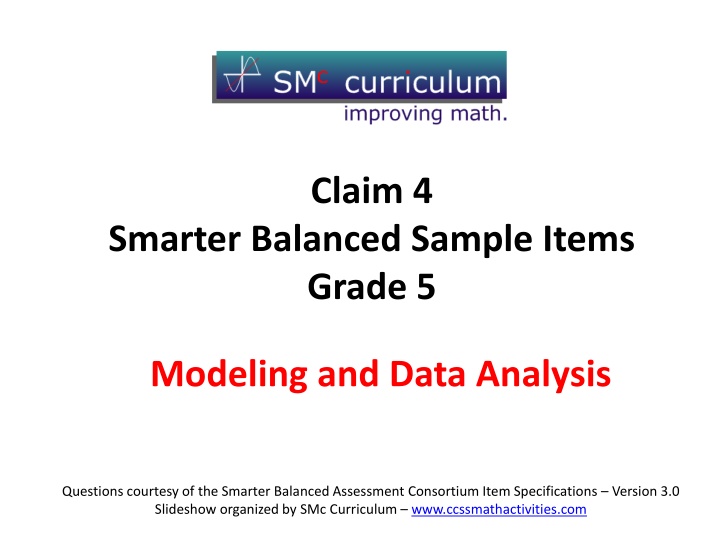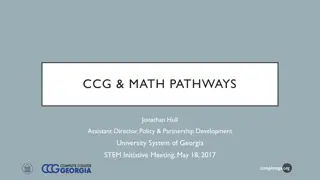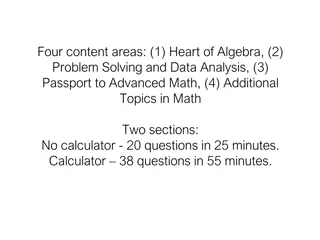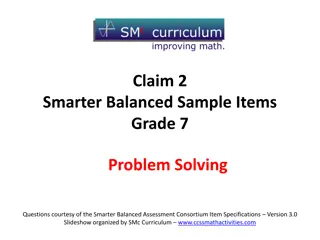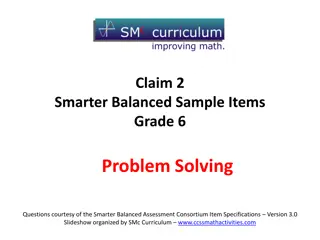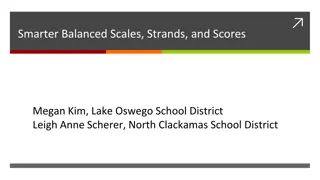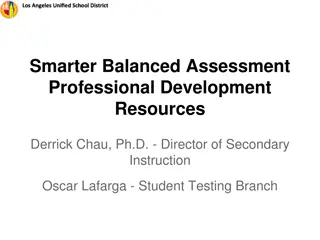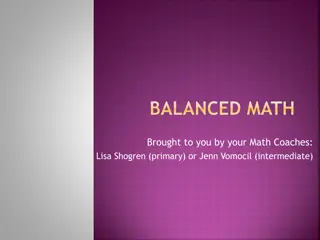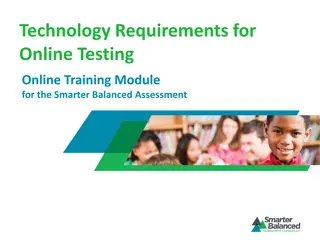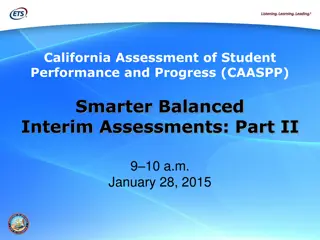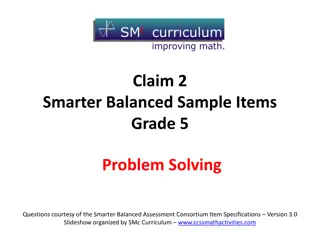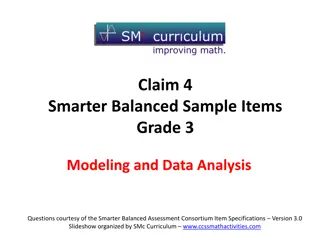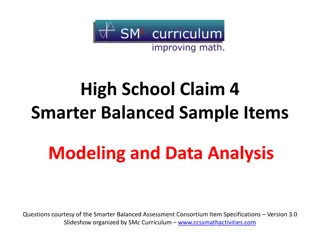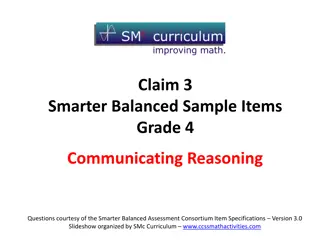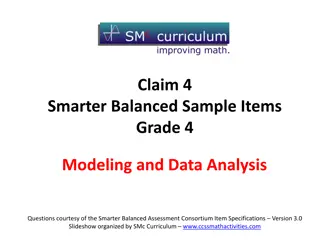Grade 5 Math Modeling and Data Analysis Questions from Smarter Balanced Assessment
Explore a set of Grade 5 modeling and data analysis questions from the Smarter Balanced Assessment Consortium. Questions involve scenarios like baking cookies, tracking race times, estimating tree growth, and calculating box masses in a truck. Test your problem-solving skills and mathematical reasoning with these engaging problems.
Download Presentation

Please find below an Image/Link to download the presentation.
The content on the website is provided AS IS for your information and personal use only. It may not be sold, licensed, or shared on other websites without obtaining consent from the author.If you encounter any issues during the download, it is possible that the publisher has removed the file from their server.
You are allowed to download the files provided on this website for personal or commercial use, subject to the condition that they are used lawfully. All files are the property of their respective owners.
The content on the website is provided AS IS for your information and personal use only. It may not be sold, licensed, or shared on other websites without obtaining consent from the author.
E N D
Presentation Transcript
Claim 4 Smarter Balanced Sample Items Grade 5 Modeling and Data Analysis Questions courtesy of the Smarter Balanced Assessment Consortium Item Specifications Version 3.0 Slideshow organized by SMc Curriculum www.ccssmathactivities.com
#1 Gina is making cookies. The last three steps used to make the cookies are shown. Step 5: Roll the cookies into -inch balls. Step 6: Place the cookies on a baking tray 2 inches apart. Step 7: Bake for 12 minutes. This recipe makes 18 to 24 cookies. Gina wants to give cookies to 9 people. She wants to give each person 3 cookies. She does not want extra cookies. Which action will help Gina get closest to the exact number of cookies she needs? A. Place the cookies 3 inches apart. B. Bake the cookies for only 10 minutes. C. Roll the cookies slightly bigger than inch. D. Roll the cookies slightly smaller than inch.
#1 Answer Rubric: (1 point) The student correctly determines which action will help Gina get closest to the exact number of cookies. Answer: D
#2 Mary, Sally, and Erin competed in a three-part race. A finish time for each person is the total amount of time to finish all three events. Mary s swim time was 0.10 hour faster than Erin s run time. Sally s finish time was 0.12 hour faster than Mary s finish time. Erin finished the race in 2.72 hours. Drag numbers into the boxes to complete the missing times for each girl.
#2 Answer Rubric: (3 points) The student is able to complete all parts of the table correctly. Each part is independently scored as 1 point. Answer: Mary s swim time: 0.80; Sally s bike time: 1.64; Erin s run time: 0.90
#3 Oliver s family planted a tree on his 1st birthday. Each year the tree grows about the same amount. Oliver s family has measured the height of the tree every year on his birthday, except they forgot to record its height on his 5th birthday. 2nd 11 3rd 31 4th 42 5th 6th 74 12 Oliver s Birthday 1st 5 12 Height of Tree (ft) ? 3 2 4 Which measurement is the most reasonable estimate for the height of the tree on Oliver s 5th birthday? 1 12ft C. 61 A. 5 6ft B. 53 D. 611 8ft 12ft
#3 Answer Rubric: (1 point) The student selects the most reasonable height. Answer: C
#4 The trailer of a truck is packed with boxes of paper. The boxes are packed 5 boxes deep by 4 boxes high by 4 boxes across, as shown in the picture. When the driver is in the truck and the trailer is empty, the mass of the truck is 2948.35 kilograms. The mass of 1 box of paper is 22.5 kilograms. The driver delivers some of the boxes of paper at his first stop. The truck has to drive over a bridge on the way to the next stop. Trucks with a mass greater than 4700 kilograms are not allowed to drive over the bridge. Enter the minimum number of boxes of paper the driver must deliver at the first stop to be allowed to drive over the bridge.
#4 Answer Rubric: (2 points) The student enters the correct whole number of boxes that must be delivered. (1 point) Partial credit is possible for correctly determining the exact number of boxes and entering any value from 2.1-2.148 or for mistakenly rounding down to 2 instead of up to 3 boxes as needed. Answer: 3
#5 Gabi measures the amount of water, in liters, in 5 identical jars. Gabi combines all of the water and then divides it equally into the 5 jars. How much water, in liters, does she put in each jar? Enter your answer in the response box.
#5 Answer Rubric: (1 point) The student correctly uses the data from a line plot to find a quotient. Answer: 9 10
#6 Adam is making muffins and cookies. He uses 31 of flour to make muffins and 21 cookies. In the first box, enter an equation that can be used to find the total number of cups of flour, f, Adam uses. In the second box, enter the total number of cups of flour that Adam uses. 2 cups 4 cups of flour to make
#6 Answer Rubric: (2 points) The student correctly enters an equation to solve the problem and correctly enters a solution. (1 point) Partial credit is available for correctly entering an equation to solve the problem or correctly entering the solution, but not both. Answer: 31 2+ 21 4= ?; 53 4
#7 How many minutes are in 1 day? More information (if needed) There are 60 seconds in a minute. There are 60 minutes in 1 hour. There are 24 hours in 1 day. There are 7 days in 1 week. There are 52 weeks in 1 year.
#7 Answer Rubric: (1 point) The student enters the correct number of minutes. Answer: 1440
#8 A parking meter accepts nickels, dimes, and quarters. It holds up to 1500 coins. Estimate the value of the coins, in dollars, in the meter when it is full.
#8 Answer Rubric: (1 point) The students enters a reasonable estimate. Answer: A multiple of 5 between 75 and 375.
#9 Part A A liter is more than a cup. Estimate the number of liters in a cup. You can use the picture to help you make an estimate. Enter your estimate, in liters, in the response box. Part B There are about 0.24 liters in one cup. How much greater or less than your estimate is the real amount? Enter the difference in the response box.
#9 Answer Rubric: (1 point) The student finds the difference between their estimate, a, and the actual number of liters. Answer: 0.24 ?
#10 A school spends $2.40 on every lunch it serves in the cafeteria and $0.30 for each carton of milk. 250 people at the school get a lunch each day 120 take a carton of milk Create an expression using this information that shows how much the school spends altogether on lunches and milk each day.
#10 Answer Rubric: (1 point) Student constructs a correct numerical expression. Answer: 250 x 2.40 + 120 x 0.30 or its equivalent
#11 A school spends $2.40 on every lunch it serves in the cafeteria and $0.30 for each carton of milk. 250 people at the school get a lunch each day 120 take a carton of milk Which expression represents the amount of money the school spends altogether on lunches and milk each day? A. 250 x 2.40 + 120 x 0.30 B. 250 x 0.30 + 120 x 2.40 C. 250 x (2.40 + 0.30) D. 120 x (2.40 + 0.30)
#11 Answer Rubric: (1 point) Student selects the correct numerical expression. Answer: A
#12 Molly and Sam need about 2 pounds of apples for a pie. Medium apples cost $0.45 each. Large apples cost $0.65 each. 9 lbs each 16 Molly says: Let s buy the medium apples, they are less expensive. 1 lbs each 3 Statement A: Molly and Sam would need __ medium apples or __ large apples for the pie. (Choose 1, 2, 3, 4, 5, 6, 7, or 8) Sam says: I think it s less expensive to buy large apples. They are more expensive but we won t have to buy as many of them. Analyze both approaches. You can use the scale to weigh the apples. Statement B: The number of medium apples that would be needed cost __ (Choose more or less) than the number of large apples that would be needed. So ___ (Choose Molly or Sam) is correct. Use the choices to complete each statement.
#12 Answer Rubric: (2 points) The student selects the correct numbers and words in all of the drop-down menus. Answer: 6, 4, more, Sam
#13 Lilian wants to estimate the number of marbles in a glass jar that has a mass of 2.3 kilograms when it is full. Part A Make an estimate for the mass of a single marble, in grams. Enter your estimate in the response box. Make an estimate for the mass of the jar, in grams. Enter your estimate in the response box. Estimate the number of marbles in the jar based on the assumptions you made. Enter your estimate in the response box. Part B The jar has a mass of about 500 grams and there are about 600 marbles in the jar. Which of the following estimates is closest to the actual mass of a single marble? A. 2 grams B. 20 grams C. 200 grams D. 1200 grams
#13 Answer Rubric: (2 points) The student estimates the mass of a single marble m and the mass of a jar b, and makes an estimate of the number of marbles in the jar that is consistent with the initial estimates and then selects the best estimate from the given choices. (1 point) The student makes an estimate for the number of marbles that is consistent with his/her estimated masses in Part A or selects the best estimate from the choices given in Part B. Answer: (2300 b)/m +/- 50; A
